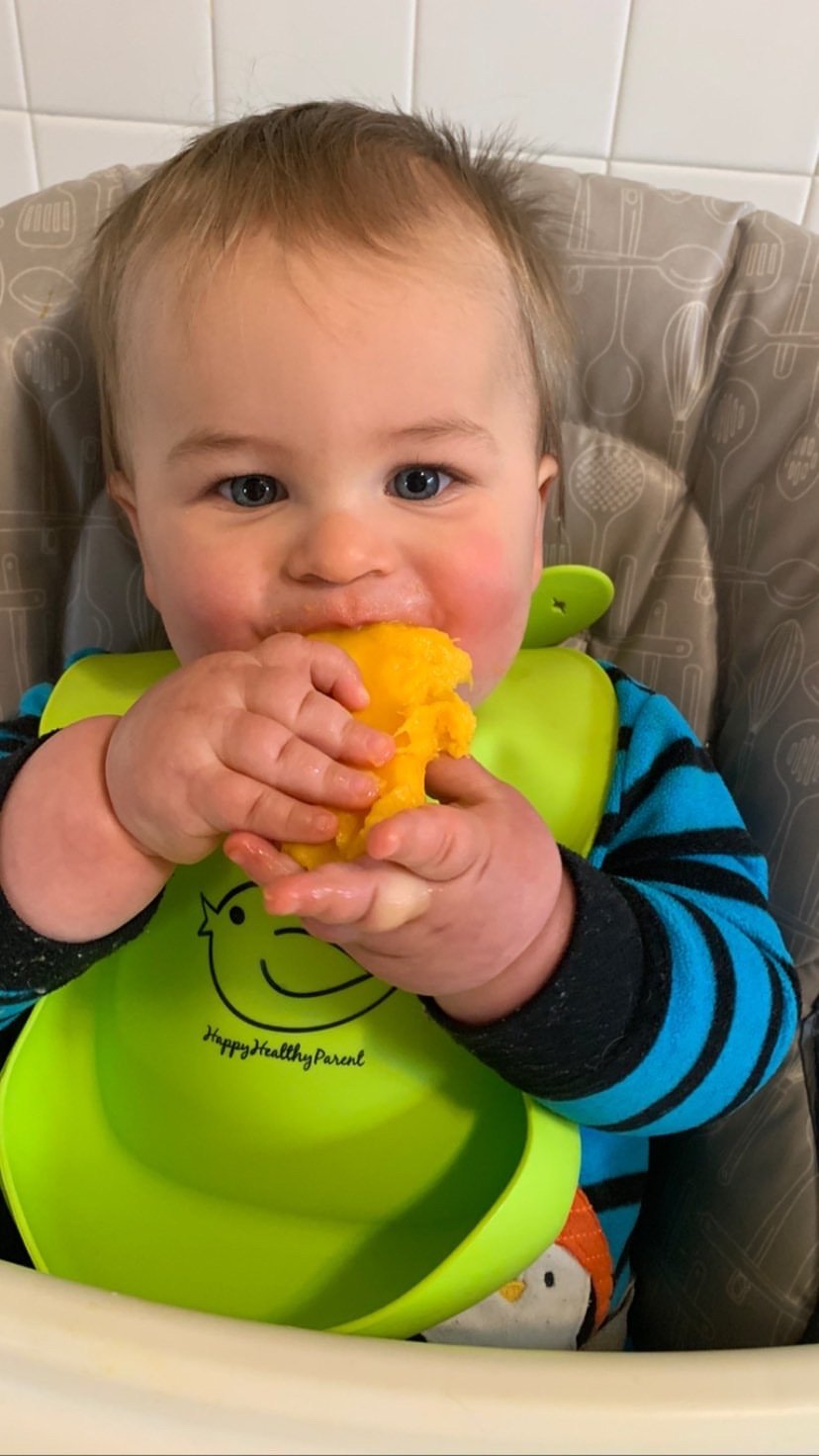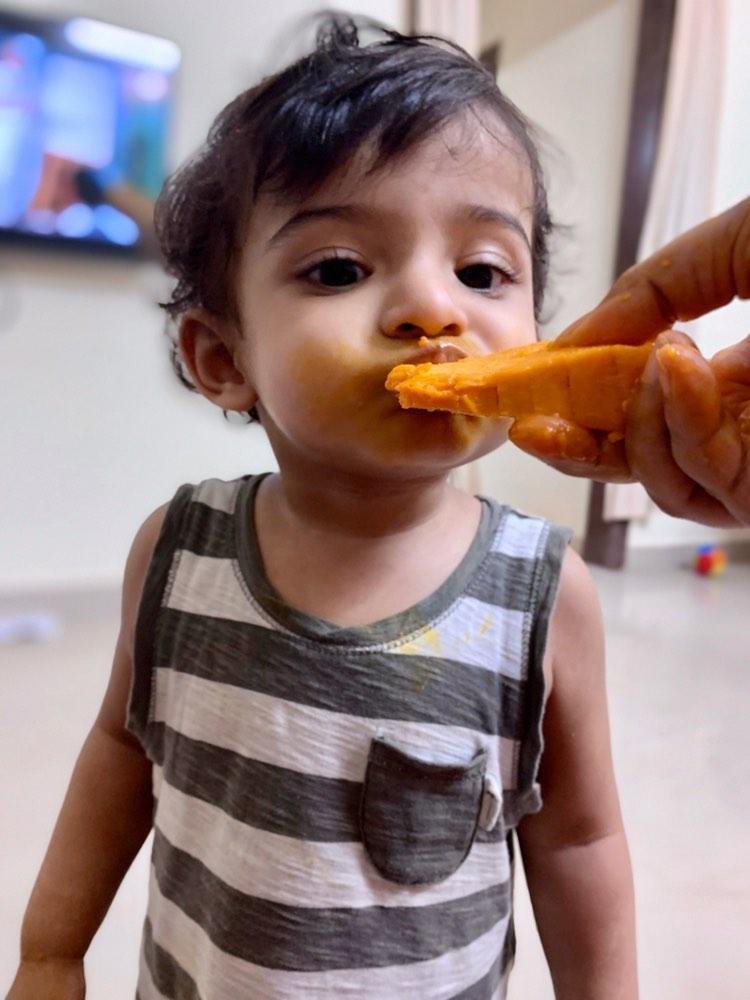How to Serve Mango to Babies During Baby-Led Weaning
This 10-month old fab fellow is nibbling some mango flesh off its pit! Big thanks to his parents for allowing me permission to share their photo.
What better way to expose babies and toddlers to different flavors and textures than by introducing them to the sweet, delicious taste of mangoes during baby-led weaning?
I recently posted a mango baby-led weaning hack on my YouTube channel that piqued the interest of a lot of parents, perhaps because when while mangoes have tons of vitamins, minerals, and antioxidants, it’s often overlooked when people assume it’s hard to cut and prepare.
How do you serve mango to a baby?
Don’t let the large, disc-like pit or the challenge of cutting mangoes stop you from buying them!
In this article, we’ll cover the benefits of mangoes for babies, how to easily cut a mango during baby-led feeding, and one of my favorite mango-pit-themed baby-led weaning hacks.
What are the Benefits of Mango for Babies & Toddlers?
Did you know that one mango has 46 g of sugar? It’s true, but don’t let that stop you from buying mangoes, either!
The recent 2020-2025 Dietary Guidelines for Americans included some specific recommendations for babies and young kids for the first time. These guidelines suggest keeping added sugar to less than 10% of a child’s diet and avoiding it altogether for little ones under 2 years old.
So, why would I suggest that babies eat mango during baby-led weaning or infant feeding?
All whole fruits contain a natural sugar called fructose. But fruit is free of added sugars and also loaded with nutrients, which makes it a GREAT finger food for babies and toddlers.
(The same isn't true for 100% fruit juice. Fruit juice is missing the fiber that's found in whole fruits. And a lot of fruit goes into making a cup of juice, which ends up concentrating the sugar).
In terms of health, here are some of the benefits of mangoes for babies:
Mangoes may support immune health
Mangoes are rich in beta carotene and C, which are essential for a healthy immune system. Vitamin C helps fight off infection, while beta carotene is a precursor for vitamin A which is essential for vision, cell growth, and immunity. Many foods are fortified with vitamin A. However, one review found that vitamin A-fortified foods alone may not prevent deficiency, highlighting the importance of a diet rich in fruits and veggies.
Mangoes may promote brain development
Fruits and veggies contain vitamin C, which helps the body absorb iron, a critical brain-building nutrient. 60.1 mg of vitamin C are found in one cup of fresh mango.
Iron helps carry oxygen to the brain, where it's used for energy production and cell development. Folate is another crucial nutrient for brain development. One cup of mango contains 71 µg.
That’s a lot of folate!
Babies 0 to 6 months old need approximately 80 µg of folate, while toddlers 1 to 3 years old need about 150 µg daily.
Mangoes make a great baby or toddler snack
A common concern of parents is how to get their kids to eat more fruits and vegetables.
Fruit is one of the best go-to foods for baby-led weaning and toddler snacks. Kids tend to accept fruit's sweet taste and soft texture, and exposure to different fruits increases your kiddo's acceptance of nutritious foods.
One study found that children who ate mango consumed less processed and sugary foods and had a more nutrient-rich diet.
How to Prepare a Mango During Baby-Led Weaning
If you're unfamiliar with mangoes, cutting them can be challenging. Mango has a large flat, fleshy pit in the center, unlike round hard pits found in peaches, nectarines or plums.
The mango pit is one of the best ways to introduce mangoes to a 6-month-old baby just starting to explore complementary foods. Yup. The pit (it’s really big).
So how do you cut around the large flat pit? Let's take a look.
Mango is usually cut into cubes or sliced. There are two ways to pit and cut a mango: peel the skin first with a vegetable peeler or remove the flesh from the cut mango last.
Step 1 - Clean the skin
Wash the whole mango. Always wash the skin of the fruit before you cut it. The outside may have pesticides, dirt, and bacteria. When you slice into the skin of fresh fruit, whatever is on the surface can transfer to the inside.
Step 2 - Remove pit
Place the mango horizontally on a cutting board and slice the ends off. Then, turn the mango vertically. Imagine a flat pit in the center and cut the fruit as if it were shaped like a cube with four sides.
Slice off the right side of the pit and then the left side of the pit. Then slice off the remaining two sides of the soft pit.
Step 3 - Cut the mango
If you didn't peel the skin: score the fruit flesh into cubes without cutting through the skin. Then, turn the piece inside out. The cubes will separate and pop out but still be attached to the skin. Then simply peel away from the skin, carefully shaving off the cubes.
If you peeled the skin before you removed the pit: cut the four sides into cubes or slices.
Can you give mango to a 6-month-old?
Around 6 months old, babies begin eating complementary foods that supplement formula or breast milk.
A 14-month old munching on a mango pit. Much appreciation to the parents for allowing me to share!
While serving unripe mango isn’t recommended because of the hardness of the fruit, ripe mangoes are soft enough for most babies to easily manage. Offer mango to babies and young toddlers in a safe feeding environment, sitting up and not left unattended.
The pincer grasp develops around 9 to 12 months old, allowing kids to grasp small objects (like Cheerios) between their thumb and index finger. During baby-led weaning, 6-month-olds can hold ripe mango slices in their fist. Fresh or frozen mango can also be pureed in a food processor and blended into a smooth mango puree for homemade baby food or smoothies.
Baby-led weaning-friendly recipes like my Mango Coconut Chia Seed Pudding can also be offered on a preloaded spoon for self-feeding.
Older toddlers have the dexterity to pick up cubed or diced mango and self-feed.
What about the pit?
Give it to your baby to enjoy. Yes. The pit! Keep reading to find out why…
Frequently Asked Questions
How much mango can a baby eat?
Introducing mangoes into your toddler's diet can help alleviate constipation. But too much mango can do the opposite. Mangoes are a low fiber and high sugar fruit, compared to other fruits. And eating too much mango can give your little one a belly ache and diarrhea.
According to the USDA, toddlers one to three years old should have about 1 to 1 ½ cups of fruit daily. So it's best to offer mango as a small portion of your kiddo's daily fruit requirements and provide a variety of other fruits for the rest.
Can mango cause allergic reactions?
Anaphylaxis, a life-threatening allergic reaction, from mango is very rare, but possible. The most common allergic reaction to mango is dermatitis, which is a contact allergy.
How to store cut mango?
Once cut, do not leave fresh mangoes out at room temperature. When refrigerated and stored in an airtight container, cut mango can last for 3-4 days.
What are your favorite baby-led weaning hacks? Let me know in the comments below.
Precious 16-month old boy being fed a slice of mango. Big thanks to his parents for sharing!
If you’re getting ready to start your baby on solids, download my FREE Baby-Led Feeding Essential Checklist to make sure you have everything you need to get started. You might also want to check out my new online course for parents, based on my best-selling book which will walk you through the whole process of starting solids using a baby-led approach.
Alternatively, if your baby is almost ready to start solids and you’re looking for someone you trust to map out the entire first 12 weeks of your baby’s solid food feeding journey, check out my new Safe & Simple 12-Week Meal Plan! Over 30 recipes, weekly shopping lists, tons of balanced baby meals, a complete plan for top allergen introduction, & lots of guidance (with photos) on how to safely serve each food.
And if you're looking for personalized nutrition support for yourself, your babies and/or your kids, I am currently accepting new clients in my virtual private practice. Looking forward to meeting you online…




